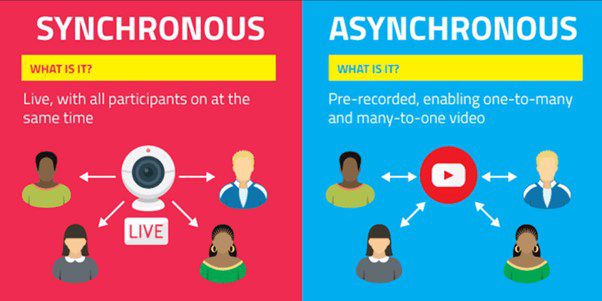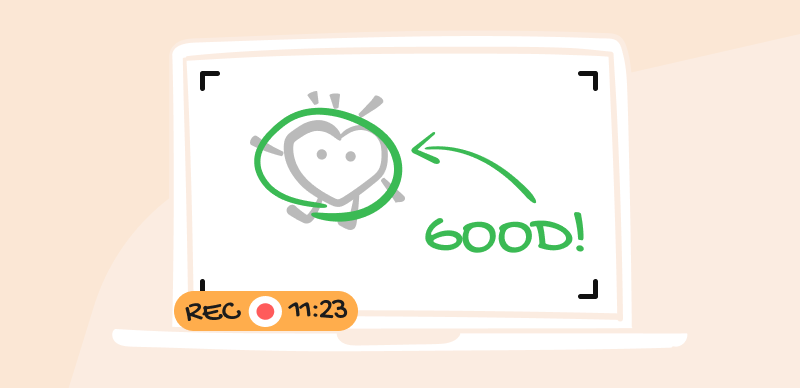Asynchronous learning and synchronous learning are two methods of education delivery that have become increasingly popular in recent years. These two methods differ in how they facilitate learning and communication between instructors and students. Whether you prefer to work independently at your own pace or thrive in a more collaborative learning environment, there is a learning method that will suit your style.
This article will briefly explain what asynchronous learning is and the differences between asynchronous learning and synchronous learning. Whether you prefer to work independently at your own pace or thrive in more collaborative visual learning, stick with us if you wish to know the advantages of each type of learning and which one might be the best fit for you.
Table of Contents: hide
What is Asynchronous Learning?
What’s the Difference Between The Two?
What is Asynchronous Learning?
Asynchronous learning is an education delivery method where students access course materials and complete assignments at their own pace and schedule. This type of learning is commonly used in online courses, allowing students to interact with the content and their classmates more flexibly. Asynchronous learning content can take many forms, such as video lectures, audio recordings, or written documents.
Discussion boards and forums are also commonly used to facilitate communication between students and instructors. For example, in an online course about graphic design, a student might watch a pre-recorded lecture on color theory, read an article on typography, and participate in a discussion board where they can share their design work and receive feedback from their peers and instructor.

What Is Asynchronous Learning
What is Synchronous Learning?
Synchronous learning is a type of education delivery where instructors and students participate in real-time communication and interaction. In this method, students attend live classes or virtual meetings with their instructors and classmates and are expected to participate actively in the learning process. Synchronous learning can take various forms, such as live video conferencing, chat rooms, and webinars.
The content of synchronous learning can include interactive activities such as group discussions, peer review, and collaborative projects. For example, in a live virtual classroom session, a professor may facilitate a debate or a case study analysis where students are expected to participate actively and discuss with their peers. The professor may also use interactive tools like whiteboards or polls to encourage engagement and active learning.

What Is Synchronous Learning
What’s the Difference Between The Two?
Asynchronous and synchronous learning are two different approaches to education delivery that offer unique advantages and disadvantages. The asynchronous learning method is ideal for students who have busy schedules or prefer to work at their own pace offering greater flexibility. On the other hand, synchronous learning provides a structured and collaborative learning environment that requires students to attend live virtual sessions or in-person classes.
Another difference between the two methods is the level of interaction between students and instructors. In asynchronous learning, students typically work independently and may communicate with their instructors through email or discussion forums. In synchronous learning, however, students can interact with their instructors and classmates in real-time through video conferencing, chat rooms, and other tools. This allows for immediate feedback and encourages collaboration and critical thinking.
Ultimately, the choice between asynchronous and synchronous learning will depend on individual student needs and preferences, the nature of the course, and the instructor’s teaching approach. Both methods have unique advantages and disadvantages, and a combination of the two may provide a well-rounded and effective learning experience.

Difference Between Asynchronous And Synchronous Learning
How Are the Two Learning Styles Similar?
While there are some differences between synchronous and asynchronous learning styles, such as the timing of content delivery and the level of interaction between students and teachers, the similarities suggest that both can effectively deliver educational content outside traditional classroom settings. Some of the similarities between these two learning styles are mentioned below:
- Online Learning: Both synchronous and asynchronous learning can be delivered online, allowing students to access educational materials from anywhere with an internet connection.
- Self-Paced Learning: Both learning styles can be self-paced, allowing students to work through the material quickly.
- Interactive Elements: Both styles can include interactive elements such as discussions, assignments, and assessments.
Which Is Better: Synchronous or Asynchronous Learning?
In general, both synchronous and asynchronous learning styles have pros and cons. Synchronous learning offers real-time interaction and collaboration with teachers and peers, allowing for immediate feedback and the chance to ask questions. This can help students feel more connected and supported in their learning. However, adhering to a strict schedule can be challenging for those with other obligations. Some students may feel uncomfortable participating in class discussions or asking questions in front of their peers.
On the other hand, asynchronous learning offers more flexibility in terms of when and where students engage with educational content. Students can work through the material quickly and review content as needed, reinforcing their understanding of the material. However, asynchronous learning can be isolating for some students and may require more self-motivation and discipline to stay on track with coursework. It depends on the individual’s choice and goals; some prefer real-time collaboration over flexibility and vice versa.
Advantages of Asynchronous Learning
- Ability to review and re-watch lectures and materials as needed.
- Opportunity to work independently and at a self-determined pace.
- Ability to manage personal and work responsibilities while still completing coursework.
- Provides equal learning opportunities for students with diverse learning styles and preferences.
- Reduces potential distractions and interruptions during learning.
Advantages of Synchronous Learning
- Sense of community and belonging among students and instructors
- Opportunity for collaboration and building professional networks.
- Ability to engage in interactive activities such as group discussions and peer review.
- Encouragement of deeper understanding and critical thinking through active participation.
Final Thought
In conclusion, asynchronous learning may be better suited for students with busy schedules or those who prefer to work independently. In contrast, synchronous learning may benefit those who thrive in a structured and interactive learning environment. However, combining both methods can provide a well-rounded and effective learning experience that meets the needs of diverse learners. If this article has helped you know what asynchronous learning is, please share your thoughts with your friends and family and leave a comment below!



